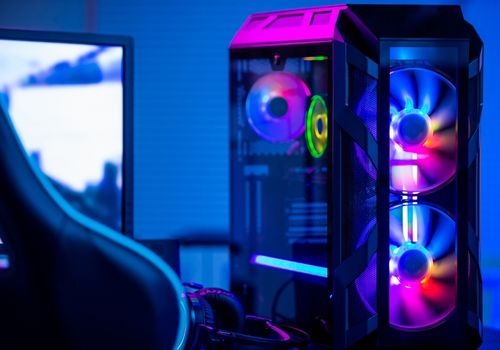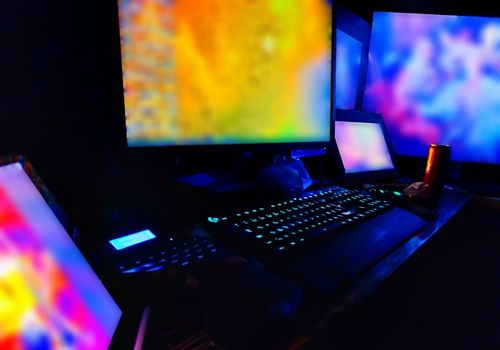
When comparing ARGB with RGB lighting, it’s important to know that each light in an ARGB strip has customizable color and intensity, whereas every light in an RGB strip must have the same color and intensity throughout. In other words, ARGB has much greater customizability then RGB.
Though they look and feel the same, the two types of RGB lighting actually aren't even remotely compatible. Unfortunately, this is something you might learn the hard way at the cost of a new motherboard, which has happened with my inexperienced gaming PC-builder friend. So I had to step in and explain the difference, to prevent him from making the same mistake again.
In this article, we'll discuss the difference between ARGB vs RGB lighting, how they differ, how they work, and any workaround if your PC doesn't actually support either of these options. So, let's dive right in.
Contents
Well, both technologies rely on employing LE (light-emitting) diodes, commonly known as LEDs, to emit light in three basic colors: red, green, and blue. Note that these aren't the same as typical primary colors (red, blue, yellow) due to lighting effects dynamics.
The main differences are in the RGB connector, called the header, located on the motherboard and the way color dynamics are achieved. However, as far as the end user is concerned, ARGB lights, also known as Addressable RGB lights, allow users to better customize their RGB devices, leading to more intricate color dynamics.
We can safely assume that RGB lighting is inferior to ARGB and, thus, more affordable and easier to produce. The increased level of customization allows for additional lighting effects that aren't possible with RGB lighting, like having your entire ARGB setup mimic the lighting effects on your monitor.

RGB stands for "red, green, blue," and it's mostly used by PC builders and gamers to add dynamic lighting effects to their PC builds. The LED strips are usually mounted inside the case and connect to 4-pin 12V RGB headers on the motherboard, usually marked as "+RGB." These headers are used to connect your RGB fans, though that isn't necessarily the case.
An RGB header provides a 12V DC power supply for the RGB lighting and data supply for red, green, and blue color channels. By controlling the amount of electrical current that passes through individual color channels, we can control the intensity of different colors and how they mix with one another.
If we observe the RGB lighting strip containing tens or hundreds of individual LEDs, we can deduce that they work in a series. This means that every subsequent LED in the strip gets the same input as the previous one, making the entire strip produce the exact same color.
These effects aren't actually static, and you can add color dynamics by customizing the current flow through each channel. This allows for more simpler light animations using RGB lights. For example, your lights can start red, fade to purple, then blue, etc.
The drawback of these strips is that they can't actually produce any intricate color animations and effects. That's because all RGBs are powered by the same RGB header and receive color instructions from a single chip.
Note that some RGB-enabled devices, like RGB RAM sticks, don't actually require RGB or ARGB header connectors. Their color dynamics are handled through a standard RAM interface. Likewise, the RGB or ARBG graphics card also doesn't require an adequate header connection.
ARGB stands for "addressable RGB" lighting technology, which allows builders and gamers to add more intricate and entirely customizable color animations to their builds. "Addressable" means that the individual lights inside and ARGB products are assigned a digital RGB value, allowing them to produce different colors.
ARGB strips are usually connected to the 3-pin 5V ARGB headers located on the motherboard, usually marked as "+5VDG." These are used to connect your ARGB fans or other ARGB lighting devices. You'll notice that the ARGB headers don't have individual color channels but rather a data inline (marked as "D"). And this is where things get interesting.
ARGBs don't work in series, and the color effect produced by a subsequent individual LED within the LED strip doesn't depend on the output of the previous LED. Instead, LEDs in an ARGB configuration have a small integrated circuit embedded within them, which controls the color output of the individual LED.
The motherboard uses the data line to send a signal to the ICs within ARGB strips or products, addressing individual ICs and telling them which color to output and for how long. This allows different LED clusters to output different colors, granting the ARGB strips to display multiple colors simultaneously.
Color combinations produced by the ARGB light are usually pre-programmed, but they can be customized using specialized software that ships with a motherboard. In a nutshell, its increased customizability allows for more creative headroom when exploring and creating different lighting options for your build.

Computer peripherals, such as higher-end keyboard and mouse combos oriented toward gaming or office work, may feature RGB and ARGB lighting. The same can be said for high-end desktop speakers.
Office and productivity-oriented peripherals usually feature static color regular RGB lights, whose power and control are embedded within the device itself. ARGBs are usually used for gaming gear, such as a high-end gaming keyboard and gaming mouse.
The power required for powering these lights is supplied by the device itself, but the color control is usually performed through some first- or third-party software.
Unfortunately, you can't actually plug an ARGB device into an RGB header without causing some damage to the device or, in the worst-case scenario, to the motherboard. Despite the similarities between the headers, they're not interchangeable in any way and may render your motherboard unfixable.
This is because of the voltage difference; the 12V analog signal used by the RGB header can be, and in most cases is, overbearing to 5V digital signal ARGB LED strips. Connecting the two will almost immediately ruin your ARGB strips and devices and, as previously stated, may lead to irreparable damage.
However, you can convert ARGB into RGB using special converters that would convert the 12V analog to 5V digital. Likewise, you can use a dedicated ARGB controller that would convert your 12V analog RGB signal output into a 5V digital ARGB signal, mimicking an ARGB header.
They can also be used to expand the number of your ARGB headers, allowing you to connect multiple strips of ARGB fans. However, in most cases, it's more affordable to replace the RGB-enabled motherboard with one that has an ARGB header than purchase a converter or dedicated controller.
Despite what you may have read, heard, or seen online, RGB or ARGB products won't impact your computer's gaming performance. They also have no effect on how well you, as an individual, play games.
Users frequently falsely assume that RGB lighting is the only factor that could affect how well you perform to make their purchase seem more significant than it actually is. This rumor's foundation is related to the fans connected to these items and the idea that blue lighting can boost gaming performance by allowing your PC to cool off more.
Those notions are just pretexts for those spreading false information to use their stylish aesthetics for other purposes. Your computer's CPU usage is unaffected, as well as your graphics card. Any problems you might experience are if you have a defective product, in which case you should disconnect it from the motherboard promptly.
With that said, most PC accessories you purchase will have a range of effects on your machine. Rarely does a new piece of equipment go undetected when it is initially brought to your PC, whether it be for looks, performance, or a combination of the two.

Although RGB lighting was initially only intended to enhance the PC and gaming aesthetics, the development of ARGB has taken that idea a step further and enhanced PC experiences. This is derived from the lightning system's adherence to certain changes in colors produced on the screen or in response to in-game events, like taking damage.
Ultimately, even though ARGB and RGB devices are widely used in productivity and entertainment settings, the former is more preferable regarding visual creativity.
